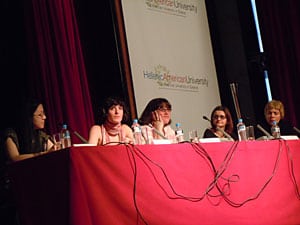Comicdom Convention, A Day of Panels at Comicdom Con
Athens, Greece
On Saturday, the first panel I attended was “Cartoons and Politics: Criticism in Ink.” Each panelist spoke in his/her own language, allowing my Cuban friends to speak in Spanish.
 Adan, on the far left, and Nico in the blue shirt, were introduced along with the other panelists, cartoonist Mihalis Koundouris (second from the right) and Dimitris Petropoulos, a journalist (far right). The man between Adan and Nico is the interpreter who was translating the political cartoons on the screen during Nico’s presentation into Greek. The first cartoons Nico showed were from the 19th century, near the end of the Spanish American War. Fortunately, I could read the cartoons as they appeared, because the explanation and the translation took quite a while. Boy, the long exposition and translation can be tedious! I could only stay at Adan and Nico’s panel for 30 minutes because there were so many great panels to attend and I had a tight schedule in order to attend them!
Adan, on the far left, and Nico in the blue shirt, were introduced along with the other panelists, cartoonist Mihalis Koundouris (second from the right) and Dimitris Petropoulos, a journalist (far right). The man between Adan and Nico is the interpreter who was translating the political cartoons on the screen during Nico’s presentation into Greek. The first cartoons Nico showed were from the 19th century, near the end of the Spanish American War. Fortunately, I could read the cartoons as they appeared, because the explanation and the translation took quite a while. Boy, the long exposition and translation can be tedious! I could only stay at Adan and Nico’s panel for 30 minutes because there were so many great panels to attend and I had a tight schedule in order to attend them!
Before leaving, though, I did get to hear many questions from the audience, including one that prompted a discussion about censorship. Nico said that while he was the director atPalante, a Cuban newspaper, no one censored him, though Adan mentioned that some newspapers abroad had tried to change some of his work. Nico explained that cartoons are just for humor, but also to make people think. According to Nico, comic books of the 1960s had an effect on their political cartoons, as word balloons were used more widely than captions, which allowed them to explore ideas more directly. Nico also mentioned that some of his cartoons, about oil for example, are still being printed today.
But the wonderful pay off of the panel for me was that the political cartoonist, Mihalis Koundouris, gathered some other Greek cartoonists Saturday night to meet with the Cubans, so they could share in discussion and conversations about the greater world of cartooning.
 Next it was off to the seminar room where Kiki, the animator, and Arlene, the PR person from the animation studios, were showing animation clips and discussing the animation studio in Havana.
Next it was off to the seminar room where Kiki, the animator, and Arlene, the PR person from the animation studios, were showing animation clips and discussing the animation studio in Havana.
Arlene (at right) spoke first, and she presented her PowerPoint presentation in Spanish. It was then the task of the interpreter to translate all that had been said into Greek. It seemed to take forever, and I found myself getting a little impatient. I was thinking to myself, “She’s only on the 1970s. I wish someone had told them to just let the interpreter translate directly from the screen.”
Interestingly, the Cubans referred to the 1980s as being the “gold era” in animation, especially with the work of director Juan Padron, who is well known in animation circles, even in the United States. At this point Kiki broke in with a comment which was too fast for me. (I can read the Spanish well enough, but when they speak it is often difficult to hold my focus as they speak so rapidly).
They ran through some very brief animation clips, but then asked if there were questions. I feared they may run out of time to show an entire clip. The fellow beside me suggested that I ask if they planned to show an entire clip—the troublemakers in class! I did, and Kiki took his seat. “Hurry, hurry, you are running out of time!” I thought… More exposition and translation—then, finally, with 5 minutes of the seminar left Kiki was ALMOST ready to push the play button, but not yet. Only 4 minutes to go… Well, I realized they were due to end at 4pm, and the next panel about “Geek Girls” with our friend Shaenon Garrity didn’t start until 4:30pm, so I could relax just a little.
Kiki presented a series of still shots of comics in panels and books. Some are similar to the political cartoons his colleague, Nico, displayed in his talk.
Finally, Kiki showed some animation bits, and each segment was followed by Q & A. There were many questions and some in the audience stopped Kiki and Arlene after the seminar. Even though I was impatient, I recognized, after asking what the questions were, that they were important and relevant to the overall panel. Most of the audience seemed interested in how politics and political topics were handled by the Cuban animation studio, which prompted Arlene to explain that while the studio will produce political campaigns when paid for them, a majority of the animation produced by their studio is made for younger audiences on television, which are not political at all in nature. One of the clips shown was a “social message” depicting how teens talk to each other and their parents about “how you know you are in love with someone.”
There was another question and answer session, which I had to ask about later because I didn’t understand the questions or the answers. One questioner wanted to know how they got access to their comic books and how did they know about Greek history. While they have limited access to consumer goods, Cuba does receive books and other merchandise from just about every country, with the United States being an exception. Kiki also answered that all Cubans learn Greek history, and both Vangelis and Aphrodite’s Child are known in Cuba. Another question dealt with whether there was an animation school in Havana. Cubans learn on the job, rather than in a school setting. There was also some discussion about the hardships in Cuba, when the Russians left in the early 1990s. For people who don’t know, Russia had been supporting much of the Cuban economy, which virtually collapsed when Russia left, leaving the Cubans to rebuild their economy.
Now off to the “Geek Girls,” which was transferred to the auditorium.
 I finally made it to “Geek Girls: Comics are a Girl’s Best Friend.” The panel was comprised of (from left to right) Sonia Leong, whose panel on Manga I attended earlier in the day; Alexia Othoneou; our Bay Area friend, Shaenon Garrity; Valia Kapadai; and Elli Moka. Lida Tsena, Art Director and Public Relations Manager of the festival was the moderator. She asked general questions about how they each got into comics and whether they were aware of discrimination in their work. Then she opened the panel to questions. It was very relaxing to sit in on a panel entirely in English, AND the women were very animated and there was a lot of give and take. It made for a good, entertaining panel. I learned a lot, including a bit about what happened when Batman had a “girl Robin,” though I’m still not entirely sure I understand it all. (There was a lot of blog discussion about it).
I finally made it to “Geek Girls: Comics are a Girl’s Best Friend.” The panel was comprised of (from left to right) Sonia Leong, whose panel on Manga I attended earlier in the day; Alexia Othoneou; our Bay Area friend, Shaenon Garrity; Valia Kapadai; and Elli Moka. Lida Tsena, Art Director and Public Relations Manager of the festival was the moderator. She asked general questions about how they each got into comics and whether they were aware of discrimination in their work. Then she opened the panel to questions. It was very relaxing to sit in on a panel entirely in English, AND the women were very animated and there was a lot of give and take. It made for a good, entertaining panel. I learned a lot, including a bit about what happened when Batman had a “girl Robin,” though I’m still not entirely sure I understand it all. (There was a lot of blog discussion about it).
Overall, the Comicdon Con was exactly what I had hoped it would be. I had the opportunity of uniting cartoonists from different parts of the world, and it was an enlightening experience to sit in on so many different panels, learning about how cartoons, comics, and animation continue to be an important part of many cultures. It was not until the end of the trip that I made perhaps my most profound realization. In telling a story about the International Cartoon Festival in Montreal in 1978, I shared how Sparky, an honorary chairman at the time, was asked to break a tie between the judges of a cartoon contest. Sparky voted for a Cuban cartoonist, and later went over to tell the cartoonist he had won Sparky’s vote. As it turns out, the cartoonist that Sparky voted for was Nico, one of my Cuban friends. It has been over a year since I first met Nico in Cuba, and I finally made the connection between him and Sparky. It was a perfect ending to quite the successful trip.
—Jean Schulz
Athens, Greece


